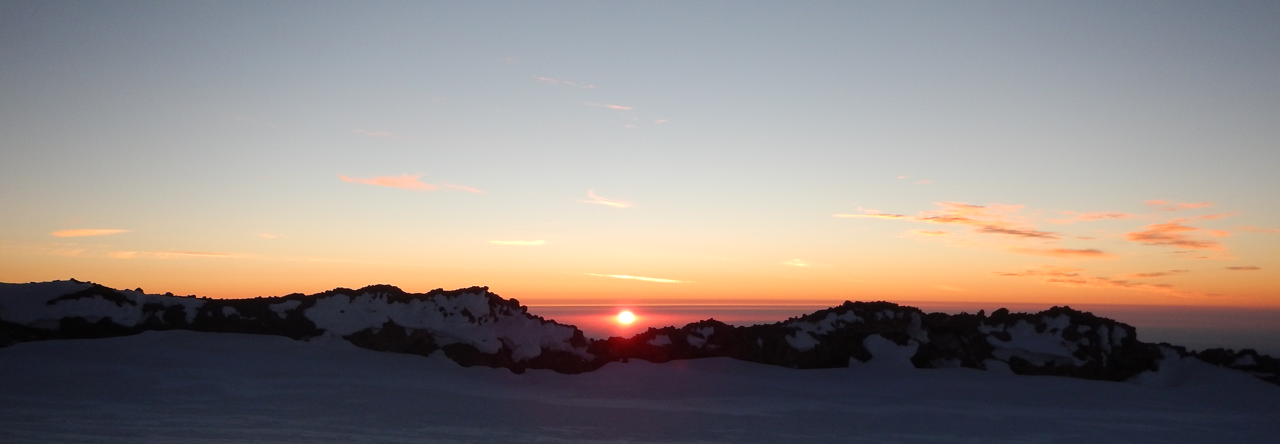Quick uphill from Timberline to Palmer on Saturday morning. I haven’t toured since climbing Mt. St. Helens last spring. I wanted to see how my new skis were on the uphill. My mountaineering skis are Volkl VTA 88 – so 88 underfoot and mostly carbon with a little piece of metal under the binding – Atomic Backland Pure Alpine tech bindings. They’re light, like super light. They’re amazing at going uphill – but leave something to be desired on the downhill – they don’t ski crud very well and chatter somewhat at high speeds.
New skis are Fischer Rangers at 96 underfoot with Salomon Shift bindings. I honestly couldn’t tell the difference on the uphill. I’ve gotten 14 days skiing this year, and just over 100K descent. I’m starting to zero back in to having a more capable ski for the descent and if I need to suffer a little bit on the uphill, so be it. Work ain’t hard, you just have to do it. I should add that I left my touring boots at home (Fischer Travers Carbon – also super light) and wore my Scarpa Maestrale RS’s – heavier, but stiffer and ski a lot better than the Fischers.







I’ve repurposed an old pair of Black Diamond climbing skins – I think they’re over 15 years old… but the glue is still good. I had to replace the tail attachments as UV and time has destroyed the rubber strap. And I crimped a new piece of swaged cable to accommodate the wider tip on the Fischers – they worked well enough. They’re short about a quarter inch on each side of ski, but it’s enough coverage to get decent purchase.
I’m somewhat of a purist on the use of heel risers. Mostly unnecessary if you’re setting a reasonable skin track. The climber’s trail up to Palmer consists of refrozen cat track right now, so mostly moderate steepness. On Saturday there was one short steep rise that I began to ski up only to realize I was on my right side starting to slide down. It happens fast. Nothing to be alarmed about and I got my skis below me and stopped. There were a couple of other climbers right behind me and I stepped aside and one of them did the same thing. Once second of pressure off the skin and he cut loose and slid down. Both of us ended up going around that section to cut the angle and I put my heel risers up for the rest of the climb.
When climbing or descending, you notice each change in the snow surface, it was softening up below, but gaining elevation it turns to hard pack, then refrozen crud, then a bit more wind blown and icy. When I got to the icy bit, I stopped to put on my ski crampons – it’s like going into 4 wheel drive low. I used those until veered left to get to the top of Palmer.
There were snowcats driving resort skiers to the top of Palmer as the lift hut is still buried. Lifties and ski patrol were starting to dig it out for Spring lift-accessed skiing. Kind of a scene as a snowcat arrives and disgorges 12 of so skiers and their equipment. I sat on my pack and ate my pbj watching them before I pulled off my skins and skied all the way back to Government camp. I think it may be the longest run in North America? If not it’s pretty close. 4500 vertical feet one way down.
Conditions were just like the uphill variation: packed, scoured conditions at the top of Palmer, sweet sweet corn snow between Magic Mile and Jeff Flood lifts, then wet and slow just before reaching Summit ski area and Government Camp where I parked.
So how did I get to Timberline on the way up to start? That, dear reader is the big secret. The Mt Hood Express Shuttle bus runs like a Japanese bullet train from Govy to Timberline – one could lap it if timed correctly. I parked in Government Camp, took the bus to Timberline, skinned to the top of Palmer and then skied all the way back to the van in Govy. Shuttle is $2. Or about $1 per 1K of vertical up. Cheapest lift ride on the mountain.







































































